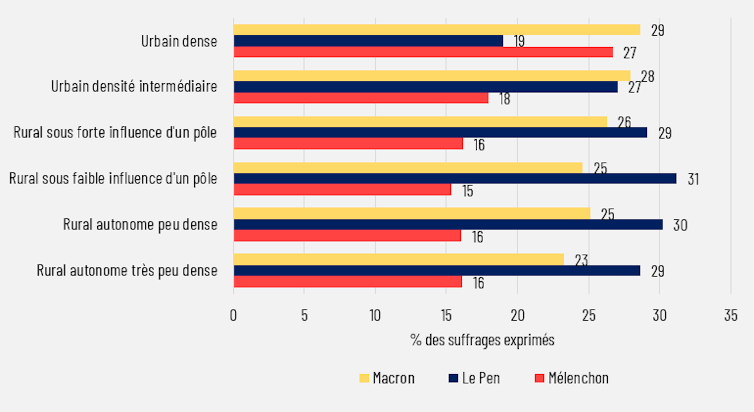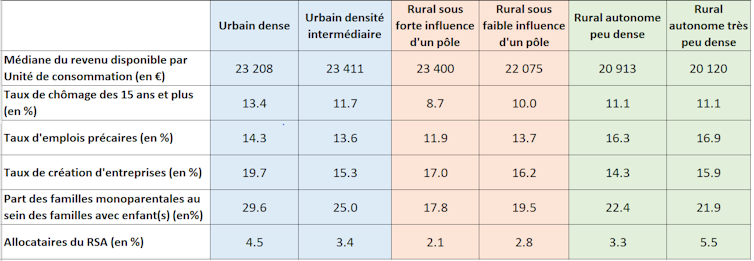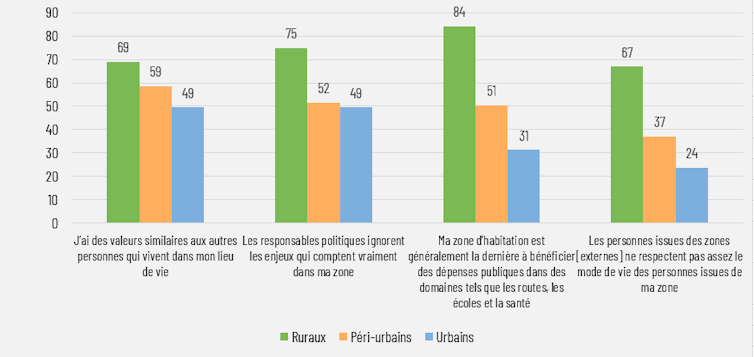Kevin Brookes is a post-doctoral fellow at Sciences Po Grenoble and the PACTE-CNRS laboratory. Marion Mattos is a student in the Master Progis program at Sciences Po Grenoble.
In the wake of the 2022 presidential and legislative elections, many commentators have been highlighting the rural-urban divide to account for the voting results. This media discourse is mainly produced by commentators who have been pointing out for years, with maps to back them up, the - growing - gap between the vote in big cities and the vote in "peripheral France". There is a political opposition between a metropolitan France, multiculturalist and a winner from globalization, and a France far from major urban centers, a loser from globalization and suffering from industrial and economic decline.
But are there really two electorally opposed France? If so, is the origin of this fragmentation essentially linked to the local economic context or to the composition of these territories?
Population dispersal by region
It's true that maps and data on urban gradients seem to corroborate this hypothesis. However, other geographers minimize the predictive effect of this geographical opposition. For them, behind living spaces lies a more complex social reality that can have an impact on voting.
Indeed, for many years now, some political scientists and geographers have been highlighting the role of socio-demographic composition at a very local level in accounting for voting.
The variation in voting according to place of residence in recent elections is primarily the result of the dispersion of populations with certain characteristics, such as socio-professional category, age, level of education or income. Place of residence would then be just the tree that hides the forest.
A new classification of communes
To contribute to this discussion, we use a new typology from Insee (2020) that divides communes into six territories.
It distinguishes rural communes - representing 33% of the population - into four categories according to their density and dependence on an employment hub corresponding to an area of over 50,000 inhabitants. The latter is measured by commuting distances. Two rural categories correspond to peri-urban (dependent on an employment hub) and two to rural (autonomous).
For example, in the Paris region, in the Yvelines département, Versailles is classified as "dense urban", Rambouillet as "intermediate urban", Montfort l'Amaury as "rural under the strong influence of a hub" (i.e. peri-urban), and you have to go further west, to the Eure-et-Loir, to find rural communes under the weak influence of a hub or autonomous.
Two areas of electoral competition
By cross-referencing this typology with the scores of the main candidates in the first round of the presidential election at commune level, we can see that there are two distinct areas of electoral competition in France: the predominantly urban communes and the others - rural and peri-urban(Figure 1).

In the big cities and their inner suburbs, the competition was between Emmanuel Macron - who scored the highest - and Jean-Luc Mélenchon. Marine Le Pen was a long way behind the first two candidates in these areas. The competition took a different form in peri-urban and rural areas, where the first round was played out between Emmanuel Macron and Marine Le Pen.
The incumbent garnered fewer votes outside the densely populated communes, while maintaining a relatively high level, albeit lower than that of his rival. The RN candidate scored best in rural communes with little urban influence. Jean-Luc Mélenchon, on the other hand, saw his score drop drastically by 10 percentage points outside dense urban areas.
This electoral gap between dense urban areas - where 37.9% of French people live - and the rest of the country is often explained by socio-economic variables.
Social and economic downgrading?
According to several hypotheses, certain areas have been abandoned by public authorities and private investors in favor of "world cities". Behind what is sometimes presented as an individual choice to live in the suburbs, there is in fact a double social and cultural downgrading: these inhabitants live in suburban areas because of the economic constraints imposed by the rising cost of rents in metropolises, and because of a strategy to avoid certain immigrant populations. All this would generate social discontent, which would be reflected at the ballot box, with a greater propensity to vote for protest parties.
The limitations of these explanations were highlighted by economist Laurent Davezies in 2021. According to him, France, a centralized state, invests massively in its territories and ensures functional solidarity. Metropolises contribute more to the state budget than they receive, and conversely, rural areas are net beneficiaries of public money.
Although globalization and the 2008 economic crisis have had a disproportionate impact on areas far from major conurbations, we think it's exaggerated to speak of "abandonment" or to use a few cases of company relocations to generalize a binary opposition between a happy France and an unhappy France.
No territorial gulf in economic terms
Looking at economic and social data by housing category also leads us to be dubious about the thesis that there are two France's(table 1).
In fact, median income levels are highest in large cities (dense urban areas), but do not differ significantly from those in suburban areas. Nevertheless, there is a relatively large gap between rural areas far from major urban centers and dense urban areas - 3,000 euros per year.

Similarly, the unemployment rate is higher in urban than in peri-urban or rural areas. The rate of precarious employment is lowest in peri-urban areas, and highest in autonomous rural areas, but the gap with cities is not immense (two to three percentage points). There is some disparity in the level of business start-ups, but again, no territorial gulf. The proportion of single-parent families, an indicator sometimes used to measure social exclusion, is higher in big cities than in rural communities. Finally, the number of RSA recipients is higher in large cities than in suburban or rural communes, except in sparsely populated communes far from employment centers.
The territorial divide observed at the ballot box does not seem to be the same in economic and social terms, judging by the above data. Generally speaking, it's not in the areas where the RN scored best (peri-urban areas) that the economic and social situation has deteriorated the most(table 1).
For example, in the department of Nord, Marine Le Pen scores much higher in peri-urban areas (37% in rural areas with little influence from a hub) where median income is higher and unemployment lower than in the department's major cities (22,100 euros vs. 20,800), while her score is lower in the department's major cities such as Lille (12%), Dunkirk (30%), Douai (28%) or Valenciennes (25%).
Remain cautious in the face of prevailing rhetoric
The presentation of this set of indicators suggests that we should take a cautious view of discourses contrasting a well-off urban France on the one hand, and an abandoned rural and peri-urban France on the other. A pilot survey carried out as part of the "Rural Urban Divide in Europe" (RUDE) project to which we belong also shows that rural and peri-urban dwellers are more satisfied with their place of life than urban dwellers (87% of rural dwellers agree with the statement "my place of life makes me happy", compared with 72% of urban dwellers).
So, if the gap in the electoral attitudes of citizens from different geographical areas is not primarily based on economic and social context, where could it come from?
The politics of resentment
It seems to us that the "yellow vests" crisis, the first demonstrations of which were concentrated in peri-urban France and medium-sized towns, has highlighted within this population the feeling of being left behind and far removed from decision-making.
A pilot survey on a limited sample conducted as part of the "RUDE" project invites us to develop this hypothesis(figure 2).
Even if there are no glaring socio-demographic gaps between cities on the one hand, and peri-urban and rural communes on the other, in terms of standard of living, there is a perception gap in terms of the resentment of these populations towards urban dwellers. In line with Katherine Cramer's pioneering work on the polarization between rural and urban voters in Wisconsin, we might speak in the French case of what she describes as a "politics of resentment".
This takes four forms: the awareness of belonging to a specific and distinct living environment, the feeling of being less well endowed with public resources than others, of receiving less attention from political decision-makers, and the feeling that one's way of life is not respected by urban elites. The second graph shows the opinions of respondents to a pilot survey according to their self-identification with a place to live.

The responses show that people from rural areas have a greater sense of belonging to their geographical area: seven out of ten rural people say they have similar values to other rural people, compared to only five out of ten urban people. Three quarters of rural dwellers feel that the issues affecting where they live are ignored by politicians, half as many as urban dwellers. The gap is even more pronounced when it comes to public resources: 84% of rural dwellers feel they are the last to benefit from public spending, versus 31% of urban dwellers. Finally, there is a strong feeling among rural dwellers that their way of life is not respected by urban dwellers. The reverse is not true: only a quarter of urban dwellers feel that rural dwellers do not respect the specific characteristics of their way of life.
Taking into account people's perceptions
This brief analysis of descriptive data in no way closes the debate on the link between where people live and how they vote, nor does it provide "proof" that the socio-economic composition of territories has no influence on the political behavior of voters at a more localized level. Rather, it invites us to consider other possible explanations. It shows how useful it is, in addition to maps, to use data provided by INSEE at commune level, as well as opinion surveys that take into account objective and subjective belonging to a place, to understand electoral dynamics.
Above all, it also invites us to take seriously the divide between urbanity on the one hand and rurality and peri-urbanity on the other, by integrating an eminently subjective dimension: the perception that individuals have of their interests and their local situation in relation to that of others.
Highlighting this divide in representations may not only be an explanatory variable for electoral behavior, but also a potential source of explanation for the crisis of confidence in liberal democracy that we've been observing for years now.
This article is republished from The Conversation under a Creative Commons license. Read theoriginal article.